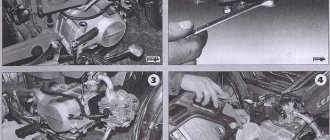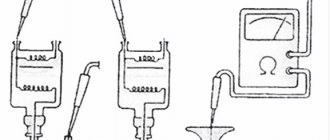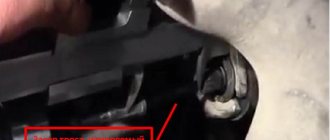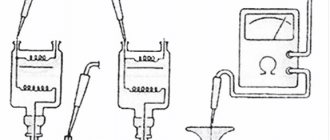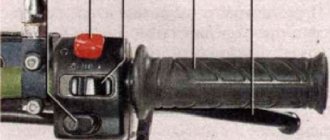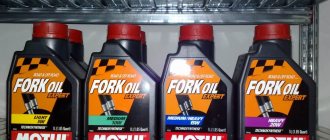Bykov K.P., Shlenchik T.A.
Changing the engine oil
The engine oil is changed after 1,000 km, and then every 2,000 km.
The engine oil is replaced on a hot engine in the following order (Fig. 18): • remove the oil dipstick (Fig. 18.1) and unscrew the nut to drain the oil (Fig. 18.2); • drain the used oil (Fig. 18.3); • after checking the condition of the sealing gasket of the oil drain nut, tighten the nut (tightening torque 2.3 kgcm); • pour approximately 0.7 liters of oil into the crankcase through the hole for the oil dipstick (Fig. 18.4); • reinstall the oil dipstick; • start the engine and let it run for several minutes at idle speed, stop the engine; • check the oil level and, if necessary, bring it up to normal.
Rice. 18. Changing engine oil
How to understand modern oil labeling?
Recently, many brands of motor and transmission oils from various companies have appeared on sale: SHELL, BP, CASTROL, MOTUL, NESTE, MOBIL, TEXACO, ELF, TEDEX, VALVOLINE, TEBOIL, etc. How to make sense of all this abundance and understand the principle of oil selection ? All oils have many indicators indicated in the technical specifications, but we, as buyers, should be interested in only two of them: quality level (will it suit my motorcycle) and viscosity (is it suitable for the upcoming season and in general for this climate). The answer to these questions is contained in the labeling of any commercial grade - the globally accepted indexing system for motor oils.
Viscosity is determined and indicated according to the method of the American Society of Automotive Engineers SAE (SOCIETy OF AUTOMOTIVE ENGINEERS). The letters SAE on the label mean that the subsequent numbers characterize the viscosity of the oil. Only viscosity, and nothing more! The letter W (WINTER - winter) is placed in the designations of winter varieties (SAE 5W, SAE 15W), while summer varieties do not have any letter (SAE 40, SAE 50). In all-season varieties, in the viscosity marking, after the letters SAE, the winter indicator first follows, and then the summer indicator. Between the two designations there is usually a hyphen or fraction sign, and sometimes nothing at all. For example, SAE 15W-40, SAE 10W/40, SAE 15W40. An example of motor oil marking is shown in Fig. 16, and the manufacturer's recommendations regarding the use of motor oils for gasoline engines are given in Table. 4.
Photo report: changing the oil in the engine and gearbox of a scooter
It would seem that it could be easier? I mixed the old oil and filled the new one, but nope. There are people who manage and punish.
Preparation
In order to throw the oil glass away from the engine, everything else. engine
Before changing the oil, it must be thoroughly warmed up. Or what would be better. Start changing the oil immediately after a 5-10 km trip.
The second preparatory step is that we need to prepare a level platform in advance on which the scooter should be installed in the flattest position and prepare a suitable container for waste oil.
The tools you use also play a strong role. Don't skimp. buy a new head with a collar. You only need two parts: 17 and 10. Those who ignore this point. then he pays a lot out of his own pocket.
Scooter with four stroke engine
For scooters with a regular gearbox, 4t oil is suitable, but if your scooter has a CVT gearbox, then you need gear oil. In the case of a 4t scooter, the choice of oil comes down to the same principle as for a 2t. That is, it all depends on the riding style, the technical condition of the moped and also its age. If we talk about four-stroke mopeds, then it is recommended to fill them with 10w-40 oil. In principle, a moped can run on regular car oil, but use such oil at your own peril and risk. The oil must protect all rubbing parts well, and there are a large number of them in the engine. And the scooter clutch especially needs high-quality oil, since it literally floats in oil.
If we are talking about what kind of oil to pour into cubic capacity motorcycles, then two-stroke synthetic is better. This way the cylinder-piston group will remain clean and well preserved. This oil is the most resistant to various temperatures. Also, synthetic scooter oil produces less soot, which settles in the muffler and clogs it.
Why change the oil
I met a person who did not change the oil for 3 seasons. His ATV was being repaired and there was little left of the oil, everything was covered in soot. And the engine was working in this one, it’s good that it was still working at all. But it significantly reduced its service life, and the repairs cost a pretty penny.
How to change the oil on an alpha moped
1. Unscrew the bolt on the bottom of the crankcase 2. Wait for oil
will merge 3. Fill in a new one 4 Rejoice)))
While the oil is draining. go to the right side of the scooter. unscrew the control probe and the oil filter plug located at the very bottom of the engine.
We put a good head on the plug on the plug, turned it and pulled it out of the engine with all its contents.
This is an oil filter. Immediately after twisting it, while the point is yes. throw all this garbage into clean gasoline, have a good chat there, and then blow and dry.
After the oil filter plug has been removed from the engine. To dislodge any remaining engine oil, bleed the engine several times using a kickstarter.
After this we will wait about five minutes. wipe the drainage holes dry, for greater reliability we place sealant on the plugs and screw them into place.
Scooter with two-stroke engine
If the scooter engine is two-stroke, then the oil for it must be 2 tons. This type of scooter eats oil and is added in small doses to gasoline (in modern 2T scooters, oil is no longer diluted with gasoline thanks to a separate engine lubrication system). Therefore, the oil must be such that it mixes well with gasoline and does not settle at the bottom and clog the carburetor. 2t oil copes well with this.
What kind of oil to pour into a 2T scooter depends on your riding style. If you drive slowly around the city or on the highway, then semi-synthetic and mineral oil are suitable for you. But if you have severe frosts and bad weather conditions, or you are always moving at full throttle, then you need synthetic oil. It does not change its properties down to -35C. Of course, under such conditions it is not recommended to ride a scooter; in this case, a car would be more suitable. It is recommended to fill a scooter with a two-stroke engine with oil from the following manufacturers:
- Motul
- Mol Dynamic
- Castrol Power
- Castrol Act Evo
- Repsol Moto (Sintetico 2t, Off Road 2t, Racing 2t, Competicion 2T)
- And other quality oils.
And even if you have an old twenty-year-old scooter, do not neglect quality oil. It doesn’t matter whether the scooter is new or old, everyone is required to ride it.
Checking the oil level
The oil level is checked as follows: pour the first portion of oil into the engine approximately 600-700 ml, wait a few minutes until the oil spreads evenly onto the crankcase without twisting, insert the dipstick into the neck, pull it out and look at the level.
The oil level should be in the control section.
- If the level is less. add some oil
, wait a couple of minutes and take a measurement. - If the oil level is higher than normal. drain it or better yet. pump it with a syringe with a tube from the neck.
The control section is indicated by red arrows. In my case, the oil level is exactly in the middle of the control section and is indicated by a blue arrow. Ideally, the oil level should be in an area outside the control interface. But this is ideal, but in practice. the average level is quite acceptable and does not affect the reliability and durability of the engine.
Scooter with four stroke engine
For scooters with a regular gearbox, 4t oil is suitable, but if your scooter has a CVT gearbox, then you need gear oil. In the case of a 4t scooter, the choice of oil comes down to the same principle as for a 2t. That is, it all depends on the riding style, the technical condition of the moped and also its age. If we talk about four-stroke mopeds, then it is recommended to fill them with 10w-40 oil. In principle, a moped can run on regular car oil, but use such oil at your own peril and risk. The oil must protect all rubbing parts well, and there are a large number of them in the engine. And the scooter clutch especially needs high-quality oil, since it literally floats in oil.
Changing the gearbox oil
At the very bottom of the engine on the left side of the road. we are looking for a drain plug and plug. The jam is on the side or top, and the drain is always on the bottom.
We replace the drain plug container, we unscrew both plugs.
We wait about ten minutes until the old oil drains from the gearbox.
Clean the drain hole and plug, apply sealant to the plug and screw it into place.
We take oil. I take a liter container so inexpensive and enough for about 10 replacements. If you change your oil infrequently. Buy a special tube of patented scooter gear oil. This is more than enough for one replacement and without additional headache, punch it with a special spout into the filled hole.
Main causes of leakage
There are only two reasons why oil may leak from a motorcycle fork:
- Rough operation - leakage in the motorcycle fork can occur when driving carelessly, when the driver ignores potholes and potholes on the roads or the driving style borders on extreme;
- Long-term downtime - in this case, the seals located in the inner part of the suspension dry out and become smaller.
Regardless of the reason for the oil loss, the procedure for replacing it will be the same, and along with it it is recommended to install new oil seals.
Checking the gearbox oil level
We pump the same control into the filler hole. oil exactly until it starts to flow out of it. As soon as the oil starts flowing. Stop pouring and wait a few minutes until the excess flows out and wraps around the plug.
On some scooter models, there is no way through which we can determine the required oil level, and instead there is a boost jumper and drain. In this case, the recommended oil level should be indicated on the engine crankcase. This makes the job easier: measure the required amount of oil and pour it through the filler hole in the gearbox.
Scooter with two-stroke engine
If the scooter engine is two-stroke, then the oil for it must be 2 tons. This type of scooter eats oil and is added in small doses to gasoline (in modern 2T scooters, oil is no longer diluted with gasoline thanks to a separate engine lubrication system). Therefore, the oil must be such that it mixes well with gasoline and does not settle at the bottom and clog the carburetor. 2t oil copes well with this.
What kind of oil to pour into a 2T scooter depends on your riding style. If you drive slowly around the city or on the highway, then semi-synthetic and mineral oil are suitable for you. But if you have severe frosts and bad weather conditions, or you are always moving at full throttle, then you need synthetic oil. It does not change its properties down to -35C. Of course, under such conditions it is not recommended to ride a scooter; in this case, a car would be more suitable. It is recommended to fill a scooter with a two-stroke engine with oil from the following manufacturers:
- Motul
- Mol Dynamic
- Castrol Power
- Castrol Act Evo
- Repsol Moto (Sintetico 2t, Off Road 2t, Racing 2t, Competicion 2T)
- And other quality oils.
And even if you have an old twenty-year-old scooter, do not neglect quality oil. It doesn’t matter whether the scooter is new or old, everyone is required to ride it.
How to change the oil on a moped?
Place the moped on the center stand so that it is level. If you want the used oil to drain more easily, you need to warm up the engine before starting, but be careful, because the engine and exhaust pipes will be hot. Then place a container under the bolt. Using a suitable tool, unscrew the bolt at the bottom of the crankcase and wait until the old oil drains out. To drain any remaining oil from the walls, tilt the moped from side to side. Then, when all the oil has drained, move the container away from the moped so as not to accidentally spill it. Using a funnel, start pouring new oil, not adding about half a liter until the tank is full. Do not add too much oil; it puts excess pressure on the seals in the engine. And do not pour used oil on the ground, because it does not evaporate and is harmful to the environment. It is better to pour the oil into a canister or bottle.
SAE classification
The latest edition of the classification divides motor oils into 11 classes: 6 winter (0W, 5W, 10W, 15W, 20W, 25W) and 5 summer (20, 30, 40, 50, 60) viscosity classes. The letter W (Winter) before the number means that the oil is adapted to work at low temperatures.
Most motor oils on the market today are all-season, that is, they meet viscosity requirements at both low and high temperatures and have a double designation, for example in our case: SAE 15W-40 . The first number characterizes the pumpability of the oil at low temperatures. If you subtract 35 from the first digit, you get the minimum temperature at which a safe cold start of the engine is possible. The second number is an indicator of oil viscosity at 100 degrees Celsius. If you add 5 to the second digit, you get the maximum permissible air temperature at which the oil can be used.
Main mistakes
Illiteracy during this procedure can be very expensive, because not adding a small amount of oil to the fork of a Honda motorcycle can lead to it not fully performing its functions and this will pose a threat to the health or even life of the driver.
Most often, such an error occurs due to the inexperience of the mechanic, because the calculation of the required amount of oil was made incorrectly. Or because the mechanic overestimated the amount of oil remaining inside the fork. In this case, it will not be possible to adjust the suspension, and riding such a motorcycle is risky.
Important to remember! The main indicator that you should rely on when calculating the required amount of oil in the fork is the distance from the level of the filled lubricant to the upper surface of the cup in a compressed state.
The second common mistake is changing oil of the wrong viscosity that is intended for these purposes; this can be based on:
- Lack of technical fluid of the required kinetic viscosity at the time of replacement;
- Lack of a service manual, or misunderstanding of the instructions.
The second reason is often committed through inattention, and the first through ignorance.
Frequency of planned replacements
The oil for a motorcycle fork is changed according to its service life after approximately 10-15 thousand kilometers; this figure largely depends on the manufacturer and its recommendations. If the replacement is not made on time, the motorcycle may lose control and the suspension will behave unpredictably.
It would be ideal to combine a scheduled oil change with a major suspension overhaul; in this case, it will be easier to replace the old seals. After a major overhaul and renewal of the seals, the fork stiffness will increase, and its adjustment can be made much less frequently.
Most often, the oil loses some of its qualities after a long winter period of inactivity, in which case it is recommended to change it as well.
The loads placed on the suspension of a motorcycle participating in sports competitions reduce the service life of the oil. In some cases, it can be reduced by three times.
Although most motorcyclists decide to change the oil only after noticeable wear of the fork. It manifests itself in dives during braking and in disruption of the bike's stability at high speeds.
Advice! In order to mitigate these problems, the oil should be replaced with one that has high kinetic viscosity.
Quality Standards
Motor oils have various specifications indicating their quality: API, JACO and others.
The oil standard is indicated on the canister. After the letters API there is a letter designation of oil quality: from SA to SM. The S scale indicates that the oil belongs to gasoline engines; the quality scale is indicated by letters from A (low quality) to M (high quality). A total of 11 quality classes are provided: A, B, C, D, E, F, G, H, J, L and M. Products with specifications from SA to SE are currently almost never produced and are only suitable for older equipment manufactured in 80s or 90s. Modern mopeds and scooters consume oil of at least SF quality, but it is better if it is SH, SJ or SL.
SH - products for engines manufactured after 1994. SJ - for engines manufactured after 1996. SL – for engines after 2000. SM – for engines after 2006.
API-TA is required for two-stroke moped and lawn mower engines. For large capacity two-stroke engines of low power - API-TB standard. For powerful large-capacity two-stroke engines - the API-TC standard.
The Japanese JASO standard is intended for models of mopeds and motorcycles with a “wet” clutch, that is, a clutch operating in an oil bath. With this design, the power unit and clutch use the same oil. Accordingly, changing the transmission oil on the scooter will occur simultaneously with replacing the engine oil. Therefore, using a high quality, low friction product may cause this clutch to slip. JASO is suitable for motorcycles manufactured before 1994 or copied models of that time. For modern mopeds and scooters, you should choose JASO MA, JASO MA-1 with a high friction coefficient. The JASO MA-2 standard has an even higher coefficient of friction, but is intended for sports mopeds and scooters. JASO MB has a low coefficient of friction and is not suitable for wet clutch vehicles.
For two-stroke engines, the JASO standard has completely different designations. JASO FA - intended for use in developing countries. JASO FB is the minimum quality standard for Japan. JASO FC is a smokeless oil for a wide range of two-stroke engines made in Japan. JASO FD – for two-stroke engines with increased requirements for the quality of motor oils.
The European ACEA oil quality designation standard is often found. Grades ACEA A1 to ACEA A5 are intended for four-stroke gasoline engines (two-stroke engines are not produced in Europe). Moreover, category A2 denotes the lowest quality oil, and A4 - the highest quality. For engines with normal operating characteristics, category A2 is recommended. Category A3 is recommended for use in motors with high performance. Category A4 is used in motorsports. Certain categories A1 (with particularly low viscosity) and A5 (the latest oils) are not suitable for all engines and are used only in cases where this is directly specified by the manufacturer.
Mopeds and mokicks made in China. Design, operation, maintenance. Delta, Musstang, Leader, Dingo, Sagitta, HongDou, Jianshe, Loncin, Simple, Zip Star, Alpa, Farmer, Dino Eriskay. >>
Maintenance of the moped. Changing the engine oil.
Bykov K.P., Shlenchik T.A.
Changing the engine oil
The engine oil is changed after 1,000 km, and then every 2,000 km.
Changing the engine oil is done on a hot engine in the following order (Fig. 18): remove the oil dipstick (Fig. 18.1) and unscrew the nut to drain the oil (Fig. 18.2); drain the used oil (Fig. 18.3); After checking the condition of the sealing gasket of the oil drain nut, tighten the nut (tightening torque 2.3 kgcm); pour approximately 0.7 liters of oil into the crankcase through the hole for the oil dipstick (Fig. 18.4); reinstall the oil dipstick; start the engine and let it run for a few minutes at idle speed, stop the engine; Check the oil level and, if necessary, bring it to normal.
Rice. 18. Changing engine oil
How to understand modern oil labeling?
Recently, many brands of motor and transmission oils from various companies have appeared on sale: SHELL, BP, CASTROL, MOTUL, NESTE, MOBIL, TEXACO, ELF, TEDEX, VALVOLINE, TEBOIL, etc. How to make sense of all this abundance and understand the principle of oil selection ? All oils have many indicators indicated in the technical specifications, but we, as buyers, should be interested in only two of them: quality level (will it suit my motorcycle) and viscosity (is it suitable for the upcoming season and in general for this climate). The answer to these questions is contained in the labeling of any commercial grade - the globally accepted indexing system for motor oils.
Viscosity is determined and indicated according to the method of the American Society of Automotive Engineers SAE (SOCIETy OF AUTOMOTIVE ENGINEERS). The letters SAE on the label mean that the subsequent numbers characterize the viscosity of the oil. Only viscosity, and nothing more! The letter W (WINTER - winter) is placed in the designations of winter varieties (SAE 5W, SAE 15W), while summer varieties do not have any letter (SAE 40, SAE 50). In all-season varieties, in the viscosity marking, after the letters SAE, the winter indicator first follows, and then the summer indicator. Between the two designations there is usually a hyphen or fraction sign, and sometimes nothing at all. For example, SAE 15W-40, SAE 10W/40, SAE 15W40. An example of motor oil marking is shown in Fig. 16, and the manufacturer's recommendations regarding the use of motor oils for gasoline engines are given in Table. 4.
Table 4. Classification of the quality level of motor oils no API.
| Designation | Application |
| For gasoline engines | |
| For designs from 1980-1988 | |
| For forced engines, production of which began in 1989-1994 | |
| For forced engines, production of which began in 1994-1996 | |
| For forced engines, production of which began in 1996-2000 | |
| For forced engines, the production of which began in 2000-20006 | |
| Newly introduced highest quality class for petrol engines | |
| For diesel engines | |
| Engines produced since 1988 | |
| Improved CD-II performance for two-stroke engines | |
| Engines manufactured since 1994. Improved CF-4 performance and stricter exhaust emission requirements |
Now about assessing the quality of the oil level. Here, the qualification system developed by the American Petroleum Institute API (AMERICAN PETROLEUM INSTITUTE) has become the international language. The Institute regularly tests all motor oils and, based on their results, assigns a quality index in accordance with the requirements of car designers. The letters API on the label precede the quality class symbols. There are two of them: S scale - use in gasoline engines; scale C - use in diesel engines. The steps of the quality level are indicated by Latin letters. The API system has 11 classes for gasoline engines (A, B, C, D, E, F, G, H, J, L and M) and 7 classes for diesel engines (A, B, C, D, E, F , G).
For gasoline engines, oils with the designations SF, SG, SH, SJ and SM are currently used, and for diesel engines - CD, CE, CF and CG. Oils of old brands - from SA to SE and from SA to SS - have passed the stage and are no longer produced. The container may be marked with the index SG-CE or SF-CD, allowing use in gasoline and diesel engines. Often on the packaging there are certificate numbers from car manufacturers, who assign them after factory tests. Examples of viscosity and oil class markings are shown in Fig. 19.
Rice. 19. Designation of motor oils: 1 - viscosity; 2 - quality class.
A lot of questions arise from people who are servicing a moped themselves for the first time.
The operating instructions require the use of oil for four-stroke engines, API SE,SF, with a viscosity of SAE 15W40.
Let's try to figure out what this means.
